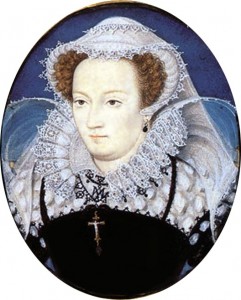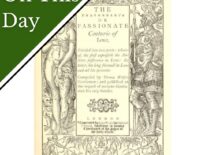 On this day in Tudor history, 25th September 1586, in the reign of Queen Elizabeth I, Mary, Queen of Scots, was moved to Fotheringhay Castle in Northamptonshire, and Elizabeth finally backed down and agreed to the appointing of 36 commissioners to act as judges in her trial. Mary would never leave the castle.
On this day in Tudor history, 25th September 1586, in the reign of Queen Elizabeth I, Mary, Queen of Scots, was moved to Fotheringhay Castle in Northamptonshire, and Elizabeth finally backed down and agreed to the appointing of 36 commissioners to act as judges in her trial. Mary would never leave the castle.
Mary had been imprisoned in England since May 1568 after she'd fled Scotland following her imprisonment there and forced abdication. She had assumed that Elizabeth I would help her fellow queen to regain the Scottish throne, and she planned for it, hoping to lead an army into Scotland by that August, but she was mistaken. Elizabeth didn't want war with Scotland and she also didn't want Mary to be a figurehead for dissatisfied Catholics who might see her as a better alternative to Elizabeth on the throne of England. So, Elizabeth had kept her captive.
Over the years, Mary was moved around, but something happened in February 1570 that would lead to Mary being executed, and that was the excommunication of Elizabeth. In the bull of excommunication, Pope Pius V wrote of Elizabeth's "wicked doctrines", called her "the pretended queen of England", and declared "her to be deprived of her pretended title to the aforesaid crown and of all lordship, dignity and privilege whatsoever". What's more, he stated that those who had made any sworn oaths to her were now absolved from those oaths, and he called on the English people to disobey her orders, mandates and laws, and threatened excommunication for those who did obey her. He was inciting a rebellion. Catholics could now plot against Elizabeth to replace her with Mary, and all with the pope's blessing.
In 1571, Mary was implicated in the Ridolfi Plot against Elizabeth, then in 1583, the Throckmorton Plot, and then, finally the Babington Plot of 1586. On 7th June 1586, Anthony Babington met with his fellow conspirators and and on 6th July, Babington wrote to Mary in code, telling her that he, with ten gentlemen and 100 followers, would release her from her prison and dispatch the usurper, i.e. Elizabeth. He wrote that six men, his "private friends", would be in charge of "that tragical execution". On 17th July, Mary made her fatal mistake. She replied to Babington, telling him to "set the six gentlemen to work", thus giving her support for Elizabeth's assassination. Mary had no idea that she had just walked into a trap. Her letters were being intercepted and the code broken by Elizabeth I's spymaster, Sir Francis Walsingham. The Babington Plot failed, with the the plotters being arrested, tried and executed.
Elizabeth's government now had damning evidence against Mary, but Elizabeth struggled with the idea of condemning an anointed monarch. However, Mary had plotted against her and she couldn't do nothing.
On 21st September 1586, Mary was transferred from Chartley Hall in Staffordshire to Hill Hall, near Abbots Bromley, and then, on 25th September to Fotheringhay Castle, birthplace of King Richard III. She would never leave.
On 14th October 1586, Mary's trial for treason began at Fotheringhay, and she was found guilty on 25th October. In November 1586, Parliament petitioned the queen to execute the Scottish queen, but Elizabeth kept stalling. On 2nd December, Parliament's final day, Elizabeth relented, allowing Mary's death sentence to be proclaimed. However, it took until 1st February 1587 for Elizabeth to finally sign Mary's execution warrant. Mary was beheaded at Fotheringhay on 8th February 1587 - you can click here to read more about that.
Also on this day in Tudor history...
Image: A miniature of Mary, Queen of Scots in captivity by Nicholas Hilliard.



Number one rule when plotting to overthrow the monarch: never put it in writing.